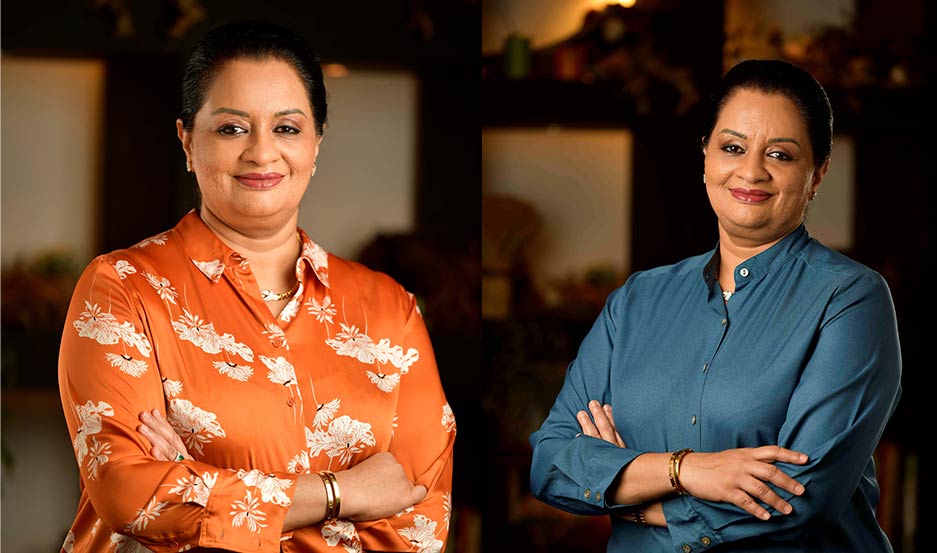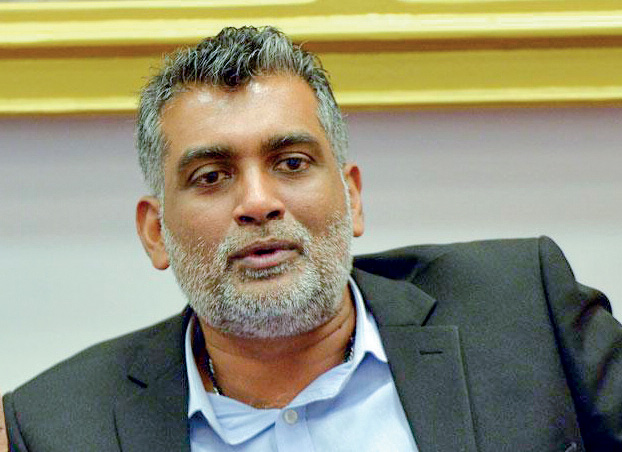Life style
Legacy of passion, quality and commitment to community

by Zanita Careem
Maliban Biscuits, a household name in Sri Lanka, has a rich history. In an interview with the Sunday Island, Managing Director of Maliban Group, A. G. Kumudika Fernando shares insight into the company’s success, brands, pioneering spirit and its remarkable journey of growth, resisilence and aspirations.
Take us through your academic journey. Share some early life influences that shaped your career?
Interestingly, I studied biology and psychology in university. While on that journey, I realised that I could combine my love for science and my entrepreneurial spirit to add value to my family’s business. My father’s dedication to Maliban and his ethical approach to business profoundly influenced me. His emphasis on quality and community values instilled a deep sense of responsibility in me and inspired my passion for excellence.
Explain your father’s influences that enrich your leadership today?
My grandfather, Mr. A. G. Hinniappuhamy, founded Maliban with a vision to provide only the highest quality products to Sri Lankans. He wasn’t just a visionary founder but also a beloved family member whose legacy continues to inspire us. My father, our current Chairman, inherited this vision and spirit and has passed it on to me. For me, this isn’t just a family business; it’s a legacy of passion, quality, and commitment to our community.
Growing up, I witnessed firsthand my father’s relentless pursuit of quality and his deep commitment to employee welfare. He skilfully balanced innovation with tradition, teaching me the importance of adaptability while staying true to our core values. His emphasis on ethical business practices and his unwavering dedication to customer satisfaction are principles that continue to guide my decisions and leadership style every day.
I am proud to carry forward the legacy of my grandfather and father, and I am inspired by their vision to continue striving for excellence and making a positive impact on the lives of Sri Lankans.
In your role as the MD of Maliban Group, what strategies do you use to drive growth?
We focus on diversification, innovation, and sustainability. Investing in R&D allows us to create products that meet contemporary consumer needs. Additionally, expanding into international markets through strategic partnerships has been crucial for growth. We also prioritise building a strong brand presence through quality assurance and customer engagement. Emphasising exports has allowed us to reach over 50 countries, and build a global presence.
What has made you so successful as an entrepreneur?
Surrounding myself with a passionate and dedicated team and fostering a culture of innovation have been vital to my success, together with a clear vision, unwavering commitment to quality, and the ability to adapt to market changes. Embracing digital transformation and leveraging data-driven insights have also been the keys
Share your most significant accomplishments in the company?
I have spearheaded our efforts to diversify our product portfolio, and expand our global presence as a trusted confectionary brand. These efforts have seen us receive the Sri Lanka National Quality Award five times and the World-Class Award at the Global Performance Excellence Awards twice, underscoring our commitment to excellence. Being ranked as Sri Lanka’s Most Loved Brand for Ready-to-Eat Packed Food by LMD is also an important achievement that I am proud of.
What strategic path have you charted for the growth phase of the Maliban Group?
We aim to enhance our global footprint through strategic partnerships and joint ventures. Emphasising sustainable practices and continuous innovation in product development ensures we remain competitive and responsive to evolving consumer demands. We are also focused on leveraging digital platforms to enhance consumer engagement and streamline operations. Strengthening our supply chain and investing in advanced manufacturing technologies are key components of our growth strategy. Additionally, we plan to expand into new product categories and markets, further strengthening our position as a global leader in confectionery.
What does the future hold for the company in your view?
We envision becoming a global confectionery powerhouse, known for our commitment to quality and innovation. Our goal is to maintain our position as the benchmark for product quality in Sri Lanka while increasing our international market share. By staying true to our core values, we plan to delight consumers worldwide with innovative and high-quality products.
What has been your success mantra?
“Pursue excellence, relentlessly!” – excellence is not a destination but a process, which involves continuous monitoring and feedback of our operations, staying attuned to consumer needs, and fostering a culture of innovation and teamwork. In this pursuit, I dedicate 10-12 hours weekly to factory visits alone, conducting rounds early in the morning, aligning with the practice instilled by my father.
What are some key milestones achieved by your company?
Expanding our product range, entering new international markets, and achieving significant quality and sustainability certifications stand out. Achieving ISO 22000 certification for food safety and receiving accredited carbon footprint certificates against ISO 14064-1:2018 reflect our commitment to quality and sustainability – in fact we were the first confectionary company to receive ISO certification, and Super Brand status in Sri Lanka. Our strong global presence in over 50 foreign markets, including the UK, USA, Australia, the EU and the UAE, all of which have some of the strictest food safety standards in the world, showcases the trust we enjoy globally.
What in your view are some of the most significant obstacles you face as a business leader in today’s corporate landscape?
Navigating economic volatility and managing supply chain disruptions are some of the most significant obstacles we face in today’s corporate landscape. These challenges are top priorities for us, as we strive to maintain the highest quality standards even as costs rise. Staying competitive in an increasingly global market is also critical.
Another key focus is fostering innovation and growth while keeping sustainability at the forefront. This is an ongoing challenge, but one we embrace wholeheartedly. Balancing the drive for innovation with the need to be environmentally responsible requires continuous effort and creativity.
Additionally, adapting to rapidly changing consumer behaviors and technological advancements are essential for our success. The pace of change in these areas is accelerating, and staying agile and forward-thinking is crucial. We are committed to meeting these demands head-on, ensuring that we remain relevant and responsive to our customers’ needs.
Overall, while these challenges are significant, they also present opportunities for us to grow, innovate, and lead our industry.
How are you able to increase your brand visibility in the current competitive market realm?
Increasing our brand visibility in today’s competitive market is a multifaceted effort. We start with strategic marketing initiatives that effectively target our audience, leveraging digital platforms to reach a broader demographic. Engaging in impactful community and sustainability projects also helps us connect with consumers on a deeper level.
Building strong partnerships has been crucial. By collaborating with other reputable brands and organizations, we amplify our reach and credibility. Continuously innovating our product offerings ensures we stay relevant and exciting in the eyes of our customers.
Maintaining high standards of quality and customer satisfaction are at the core of our strategy. When customers are happy, they naturally become advocates for our brand, driving strong word-of-mouth promotion. Additionally, participating in several international trade fairs each year allows us to showcase our products and network with industry leaders, further enhancing our visibility.
Ultimately, our success comes from a combination of these efforts, all aimed at creating a strong, recognizable brand that resonates with consumers globally.
What is your approach towards gender equality in the company?
Our approach towards gender equality is rooted in creating an inclusive work environment where everyone has equal opportunities for growth and development. We prioritize implementing policies that support work-life balance, ensuring our employees can thrive both professionally and personally.
Leadership training and mentorship programmes are key initiatives for us. We actively promote diversity and work to ensure fair representation of women in leadership roles. This not only empowers our female employees but also enriches our company culture with diverse perspectives.
Encouraging open dialogue and feedback is vital to our strategy. It helps us understand our employees’ needs and continuously improve the inclusivity of our workplace. By fostering a supportive and equitable environment, we aim to build a company where everyone feels valued and can contribute to our collective success.
13) Is an environment of leadership and mentorship a catalyst for women to ascend to influential roles?
Leadership and mentorship programs are essential in nurturing talent, providing guidance, and empowering women to take on influential roles. By offering mentorship and career development opportunities, we help women build the confidence and skills necessary for leadership positions.
Encouraging a culture of collaboration and continuous learning ensures that women have the resources and support they need to excel. This approach not only benefits individual growth but also enhances our organizational performance and innovation.
At Maliban, we believe in a meritocratic environment where everyone, regardless of gender or any other immutable characteristic, has the opportunity to thrive. Our commitment to quality and excellence are shared by all our employees, and we are proud to support their journey towards leadership and success.
Life style
Cinnamon Life at City of Dreams receives prestigious five-Star certification from SLTDA

Cinnamon Life that has re-defined Colombo’s skyline added another accolade to its journey as it officially received its five star certification placing it among the most distinguished luxury properties in Sri Lanka’s hospitality landscape.
Receiving the five star classification is a significant achievement for any hotel but Cinnamon Life – the flagship of Sri Lanka’s most ambitious integrated lifestyle development, the accolade carries exceptional meaning. The recognition follows a rigorous evaluation of service standards,facilities,and operational excellence,underscoring the property’s commitment to delivering world class guest experiences
– Cinnamon Life at City of Dreams has been officially awarded the esteemed Five-Star Certification by the Sri Lanka Tourism Development Authority (SLTDA), underscoring its status as a landmark in Sri Lanka’s hospitality landscape and a benchmark for excellence in the region.
As South Asia’s largest and first fully integrated resort, Cinnamon Life at City of Dreams represents a transformative investment in Sri Lanka’s tourism and leisure economy. Developed by John Keells Holdings PLC with a historic USD 1.2 billion investment – the largest private development in the country – the resort has reshaped Colombo into a premier destination for luxury travel, entertainment, world-class events, and international business.
A hallmark of the property is its extensive event and convention infrastructure, featuring over 160,000 sq. ft. of versatile, high-spec event space. With five signature ballrooms, cutting-edge technology, and three exceptional outdoor venues offering panoramic views of the ocean and the Colombo skyline, Cinnamon Life has established itself as an unrivalled hub for global conferences, high-profile celebrations, and corporate gatherings for both local and international travellers.
“We are deeply honoured to receive this Five-Star Certification from the Sri Lanka Tourism Development Authority,” said Sanjiv Hulugalle, CEO and General Manager of Cinnamon Life at City of Dreams. “This recognition reflects our unwavering commitment to world-class service, guest centric innovation, and the elevated experiences that define Cinnamon Life. Our aspiration is to set new standards for luxury, leisure, and MICE tourism in the region, while supporting Sri Lanka’s positioning on the global stage.”
The Five-Star Certification further cements Cinnamon Life at City of Dreams as one of Sri Lanka’s foremost luxury destinations. With its two luxury hotels, curated signature dining concepts, immersive entertainment arenas, and a vibrant retail and lifestyle precinct, the resort offers an unparalleled blend of hospitality, lifestyle, and experiences under one iconic address.
The certification was presented at Cinnamon Life, attended by senior leadership from SLTDA and Cinnamon Life, members of the hospitality industry, and media representatives. The event celebrated this milestone achievement and marked a significant step forward in elevating Sri Lanka’s luxury hospitality offering.
About City of Dreams
City of Dreams is Sri Lanka’s largest and most ambitious integrated resort, redefining Colombo’s skyline as a symbol of modern luxury and innovation. Designed as a “city within a city,” the destination offers 800 luxury rooms and suites, with 687 at Cinnamon Life and 113 at NUWA, complemented by a diverse selection of 13 restaurants and bars that showcase global cuisines alongside Sri Lanka’s rich culinary heritage. Adding to its appeal is a vibrant mix of high-end retail, Sri Lanka’s premier entertainment arena, a shopping mall, office towers, and luxury residences. This integrated ecosystem enables delegates to stay, work, meet, dine, shop, and celebrate seamlessly under one roof, delivering unmatched convenience and engagement.
Life style
Tourist Board reassures: Sri Lanka safe, open and ready

Cyclone Ditwah carved a trail of devastation as it roared across many regions, unleashing a deluge that transformed the entire towns into destruction. This is one of the most unforgiving storms in recent years – bringing torrential rains, violent winds and a trail of destruction that left thousands displaced in a matter of hours. Homes swept away, roads disappeared and families were forced to flee.
Yet beneath the chaos and loss, a quiet resilience emerged, communities rallied, rescue teams worked around the clock to restore roads, relocate displaced families and ensure the safety of the tourists.
Now with waters slowly receding, the full story of Ditwah’s impact is only a beginning to unfold – a story of heartbreak, survival and the long road to rebuilding.
Cyclone Ditwah delivered a sharp blow to the tourism sector within hours and days, disrupting travel routes, damaging coastal routes, and forcing authorities to reassess visitor safety. as hoteliers,tour operators,and government agencies worked round the clock to stabilise operations.The industry soon reassured global travellers that the island remains open and resilient.Rescue teams were deployed immediately, working around the clock to evacuate families and restore essential services.
While several areas experienced significant damages, authorities assured that key tourism zones remain safe and operational.
 A press conference was summoned by the Ministry of Tourism and Foreign affairs, last week bringing together top officials, media and other hospitality partners to address growing public concern,assure international travellers and outline the immediate steps taken to ensure safety across all tourist zones. The Deputy Minister of Tourism, Professor Ruwan Ranasinghe and Chairman of SLTPB, Buddhika Hewawasam stepped forward to present a clear,unified message that Sri Lanka remains safe, prepared and committed in protecting the visitors. They calmed anxieties,dispelled myths,rumours and dispelled misinformation and revealed the coordinated efforts of the government to keep the hospitality industry unshaken.
A press conference was summoned by the Ministry of Tourism and Foreign affairs, last week bringing together top officials, media and other hospitality partners to address growing public concern,assure international travellers and outline the immediate steps taken to ensure safety across all tourist zones. The Deputy Minister of Tourism, Professor Ruwan Ranasinghe and Chairman of SLTPB, Buddhika Hewawasam stepped forward to present a clear,unified message that Sri Lanka remains safe, prepared and committed in protecting the visitors. They calmed anxieties,dispelled myths,rumours and dispelled misinformation and revealed the coordinated efforts of the government to keep the hospitality industry unshaken.
Tourism authorities pointed out even in the aftermath of Ditwah,the arrival of the cruise ship sent a powerful message. the ship’s docking underscored that Sri Lanka is safe . The arrival of this luxury cruise liner carrying hundreds of international passengers, was part of a regional voyage from Mumbai to Singapore. This was a symbolic moment unfolding at the harbour, it was a glimmer of hope in a week overshadowed by stormy clouds. The Tourism authorities reflected this arrival as a sign that confidence in Sri Lanka had not lost hope and showed Sri Lanka is steady,ready,and open.
The Deputy Minister of Tourism Professor Ruwan Ranasinghe in a speech marked by confidence and determination said. “Our teams have worked round the clock to ensure safety, restore access routes and support our travellers”.
Today I assured every traveller Sri Lanka is safe, Sri Lanka is open, and Sri Lanka is ready. He confirmed that all major coastal resorts from Negombo to Bentota remain fully operational. Cultural destinations such as Kandy, Dambulla, Kandy,Sigiriya, are now open. He further noted that national parks,including Yala, Udawalawe,Wilpattu had returned operations following rapid assessments. Our key tourist zones are open,accessible and operating under verified safety conditions. He assured that every tourist in the island was safe,
He praised the rescue teams who had worked round the clock, cleaning roads, supporting displaced families and ensuring tourism infrastructure remained intact. To the world I say please come visit, and explore. Our island stands tall and more ready than ever to welcome you. This is not just recovery, he concluded,this is resilience in action. Finally he stressed that Sri Lanka’s tourism sector had demonstrated structural resilience,operational continuity and readiness to maintain international confidence.
The Chairman of the SLTPB Buddika Hewawasam also briefed the media on the ongoing relief operations. He acknowledged the sharp blow and destruction but underscored the country’s resilience. We want to assure travellers that Sri Lanka remains safe. Our teams are on the ground, our infrastructure is being restored and our hospitality sector stands ready to welcome visitors as recovery unfolds.
He said “New the waters have receded, and Sri Lanka is ready to welcome the world. Cyclone Ditwah swept through the island with devastating force, but in its aftermath, a story of resilience, beauty and unwavering hospitality has emerged – one that travellers are invited to witness firsthand”.
For travellers, this is a chance to experience a Sri Lanka that is vibrant and sparkling with life where cultural heritage, natural beauty and warm hospitality blend. Cyclone Ditwah may have left a mark, but it could not dim the island’s radiance.
The Tourism sector is preparing to move forward with renewed emphasis on resilience, safety and rebuilding confidence among international travellers. Sri Lanka has weathered the storm and the world is already sailing back to its shores.
Life style
Championing mental health, rehabilitation, and social upliftment

Tiesh jewellery , announced a meaningful partnership with the Infinite Grace Foundation Sri Lanka, an organisation dedicated to transforming lives through love, dignity, purpose, and long-term social impact.
This collaboration marks a significant milestone as two Sri Lankan entities join hands to address some of the country’s most urgent and overlooked challenges, including mental health, drug addiction, prisoner rehabilitation, anti-human trafficking awareness, and the empowerment of estate communities.
Founded on the belief that “Every life deserves to be seen and loved,” the Infinite Grace Foundation symbolises hope, transformation, and inclusion. The Foundation works to extend a lifeline to those often ignored or marginalised, ensuring they are reminded that they are valued, loved, and never alone.
Their vision is deeply aligned to create a Clean Sri Lanka—not only in its physical environment, but in its hearts, minds, and communities. Through systemic intervention, awareness, and rehabilitation, the organisation aims to restore dignity, provide second chances, and help individuals reclaim their potential.

Stephanie Siriwardhana, Founder of the Infinite Grace Foundation and Brand Ambassador for Pure Gold by Tiesh
As part of its awareness and empowerment initiatives, Infinite Grace Foundation has launched the “I See You” campaign—an effort to recognise, support, and uplift individuals who have long been overlooked. Through this campaign, the foundation aims to promote year-round advocacy, encompassing mental health support, panel discussions, and collaborations with organisations and hotlines that support vulnerable groups across the island.
In support of this meaningful initiative, Tiesh has designed an exclusive jewellery collection created with intention and purpose. All proceeds from the collection will be donated directly to the Infinite Grace Foundation. The range features intricately crafted earrings, pendants, chains, rings, and more for women, as well as bracelets, cufflinks, lapel pins, and rings for men. Offered in diamonds, as well as gold and silver, each piece carries a profound message—that every life deserves to be seen, acknowledged, and loved.
With a legacy spanning more than two decades, Tiesh founded by Lasantha and Bryony De Fonseka, has become synonymous with innovation, excellence, and artistry in Sri Lanka’s jewellery landscape. Today, the family-run business is led by the next generation, with Directors Ayesh De Fonseka and Thiyasha De Fonseka continuing to uphold the brand’s commitment to integrity, community, and craftsmanship.
Stephanie Siriwardhana, Founder of the Infinite Grace Foundation and Brand Ambassador for Pure Gold by Tiesh, expressed the impact of this partnership: “This collaboration is special in many ways, and I’m truly grateful that a prestigious jeweller like Tiesh cares about communities that are often unseen—such as prisoners and estate workers. When you change one life, you change a family. When families transform, communities transform, and soon you change the nation. This initiative comes from a personal place. Many people struggle to ask for help, including myself. Through the ‘I See You’ campaign, we aim to provide support, raise awareness, and offer year-round mental health programs, alongside organisations and hotlines that are equipped to help victims and individuals in need. This partnership with Tiesh will be deeply impactful.”
The work of the Infinite Grace Foundation spans multiple critical pillars, including prison reforms, addiction rehabilitation, community education, vocational training, anti-human trafficking awareness, and mental health destigmatisation—all designed to create long-term, sustainable change across Sri Lanka.
Reflecting on the significance of the collaboration, Director of Tiesh, Ayesh De Fonseka, added, “Helping the community is rooted in our beliefs and upbringing. This partnership presented a meaningful opportunity to give back and support an important cause. We believe in second chances, and many individuals need guidance, care, and the opportunity to rebuild their lives. We are honoured to donate all profits from this collection. In the future, we hope to extend support further by offering job opportunities—whether in jewellery craftsmanship, box making, design, or other livelihood pathways.”
Through this partnership, Tiesh and Infinite Grace Foundation reaffirm their shared commitment to building a Sri Lanka where hope thrives, opportunities are equitable, and transformation is within reach for all.
For those wishing to support this initiative or explore the special collection, please visit the Tiesh showroom at 253 R. A. De Mel Mawatha, Colombo 03, or follow Tiesh on social media for updates and campaign information.
-

 Features5 days ago
Features5 days agoFinally, Mahinda Yapa sets the record straight
-

 News7 days ago
News7 days agoOver 35,000 drug offenders nabbed in 36 days
-

 News6 days ago
News6 days agoCyclone Ditwah leaves Sri Lanka’s biodiversity in ruins: Top scientist warns of unseen ecological disaster
-

 News7 days ago
News7 days agoRising water level in Malwathu Oya triggers alert in Thanthirimale
-

 Features5 days ago
Features5 days agoHandunnetti and Colonial Shackles of English in Sri Lanka
-

 Business3 days ago
Business3 days agoCabinet approves establishment of two 50 MW wind power stations in Mullikulum, Mannar region
-

 Business7 days ago
Business7 days agoSri Lanka betting its tourism future on cold, hard numbers
-

 News7 days ago
News7 days agoJetstar to launch Australia’s only low-cost direct flights to Sri Lanka, with fares from just $315^



